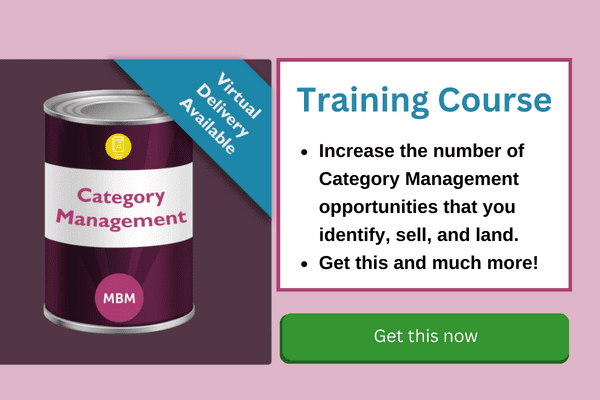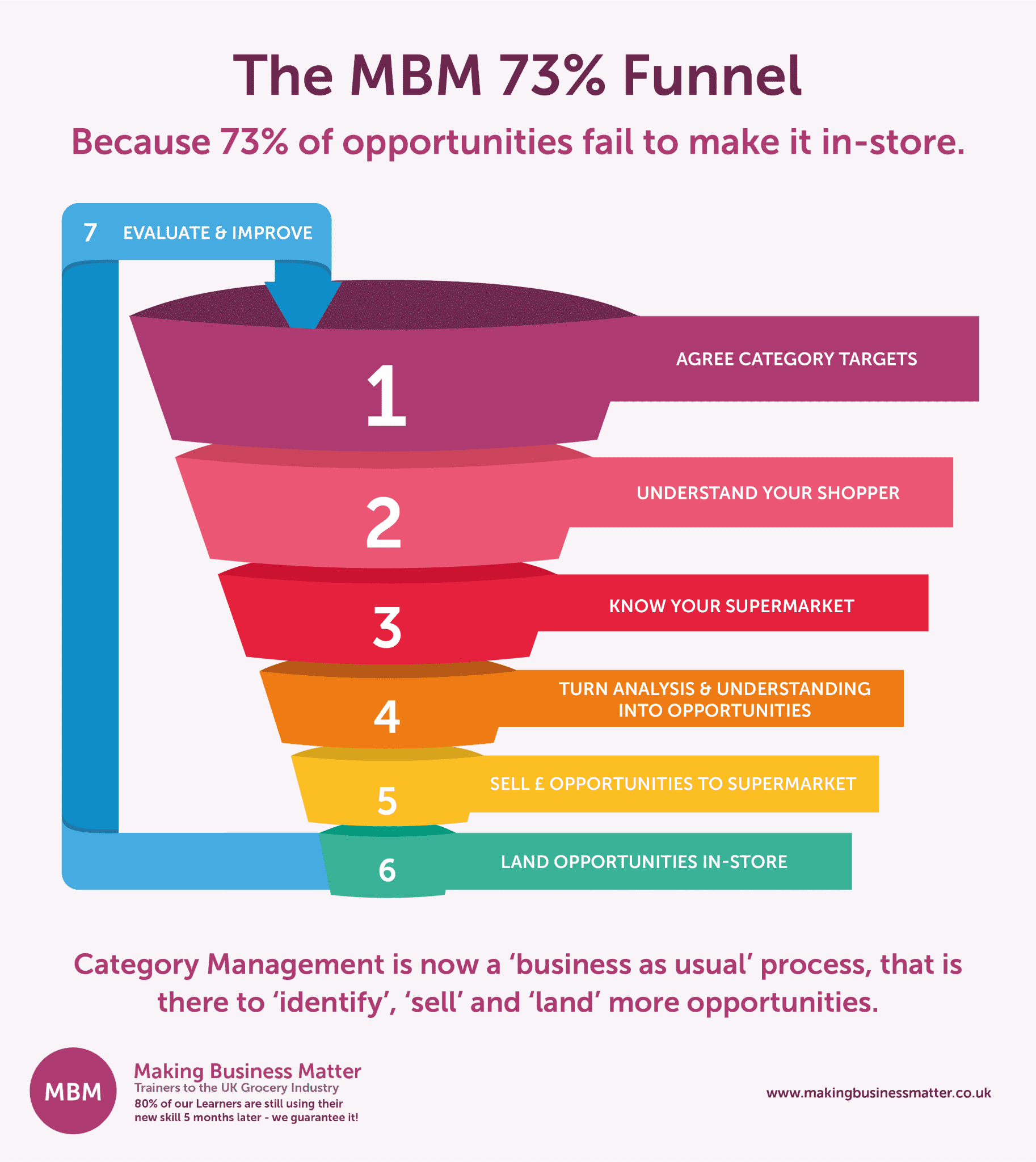The Benefits of Category Management are Improved Category Performance for Everyone Involved
To realise these benefits the range of products is broken down into groups to make it more manageable, called ‘Categories’. Let’s look more closely at the seven benefits of adopting the discipline of Category Management.
7 Benefits
#1 – The Customer Wins
Firstly, the customer. Without whom no business exists. Category Management has been long rumoured to be dead, yet the first principle of Category Management is meeting the customer’s needs. If meeting a customer’s needs is dead then Category Management is too. Yet, of course, giving the customer what they want is paramount to business success and Category Management is no different in wanting to achieve this.
Wider range, better quality, improved availability…whatever the customer needs, Category Management should provide. Through shopper understanding, leading to insights, a Category Manager aims to identify category opportunities and deliver them, better & quicker than their competition. For example, from the innovative – customers struggled to read maps, the sat nav was born, to the evolutionary, Mum wants to buy bigger packs of fish fingers – larger packs were produced, to the revolutionary plant-based explosion.
Meeting customer needs is the first benefit of Category Management and by doing it better and quicker than your competition, your business thrives. First, the challenge is to have a desire to seek the information from the customer through focus groups, mining data or comparing yourselves to your competition, and so on. Then, understanding the information, and then delivering a solution that meets the customers’ wishes.
From my own experience as a pizza buyer for a supermarket, microwave pizzas were a wish from the shoppers, because of the convenience. However, the launch failed because what we gained in speed we lost in product quality by not having a crispy base. Lesson learned.

#2 – Great Category Insights
Category Management is largely a data-driven concept. Using information to identify performance and therefore opportunities. In our Category Management training course, we teach the Learners that there are 3 broad aims of Category Management; 1. Identify category opportunities, 2. Sell the category opportunities, and 3. Land the category opportunities in-store. Great Category Managers do these 3 aims regularly, with success, and achieve huge improvements in their category performance.
The challenge with Category Management is the abyss of data. There is no shortage of data about your categories in the information age. Getting lost in the data is an occupational hazard for any Category Manager and using the 73% funnel can help. Plus, approaching data with a healthy amount of disregard for data that leads to no insights, only providing observations, remembering that ‘information without application is just entertainment’.
Click the image below for a higher resolution.

Sticky Learning ® is 7 times more effective than 1-day training courses. Plus, you will get a Chain of Evidence proving your Return on Investment. Discover soft skills training that changes behaviours long term.

#3 – Understanding the Shoppers
Win over the shopper with an easier-to-shop range, better category communication, easier to open packs, and more. The list is endless. If you make these changes and make them successfully you achieve great market share, sales, and the all-important profit. Category Management drives us to know our shoppers better than the competition. Partly through a thirst to dig deeper and deeper into the data to know why, and also through a relentless desire to know what the shoppers want next. Innovate before the competition. Be first.
This thirst is almost a quest to satisfy our shoppers completely, and better than the competition – a never-ending quest driven by wanting to be the best. A great Category Manager celebrates when hearing from their shoppers that the new range solved the problem of getting a meal ready for the family in under 20 minutes. Or that the healthy range enabled calorie counting. Or that the perfect treat for a special night was perfect. This is what drives Category Managers and adopting Category Management is one of the benefits.
#4 – ‘Know Thy Spend’
Since Category Management arrived in the late 1990’s retailers and suppliers have been plagued by an irritation that their promotional plan is a carbon copy of yesteryear. Yet transforming it into something different has been always on the hard-to-do pile. Category Management encourages us to understand where we spend our investment and what we get back in return. The millions spent on posters hanging from the ceiling, & floor stickers, and yet the shopper looks from above two feet above the floor to eye height and nothing higher or lower. Good investment? Probably not.

Creating a promotional plan that achieves a positive return on investment starts with throwing out what we did before and then identifying an objective. What do we want the shopper to do differently? Do we want them to buy more? Yes, but if we promote x product, do they just move their spend to y, and does that benefit us? We need to understand cannibalisation.
If we want the shopper to try our new product, do we want to attract new shoppers to the category, rather than sell to our existing shoppers? Yes, then how do we market to new shoppers. Those that aren’t already buying from the category. Where do those new shoppers shop? The tough questions need to be asked and answered if we are to achieve a positive return on our promotion spend.
Creating a promotional plan that is objective-driven, measured, and includes shopper metrics is the holy grail and that gauntlet should no longer be ignored by any Category Manager.
#5 – Hungry For More
Category Management started with a simple principle, to meet the shopper’s needs better, and then became its own subject, its own philosophy, its own topic. From simply trying to understand from the shopper – what can we improve, and then doing it, we became more sophisticated in how we saw every aspect of Category Management, and so the shopper.
As an example, the shopper, for us at MBM, became the preparer, eater and shopper. Mum buys the fish fingers – shopper, Dad cooks the fish fingers – preparer, and the kids eat the fish fingers – the eaters. By knowing this, we can now ask different questions of each of the 3. What are their barriers? And their motivations? Dad might want to see the cooking instructions more clearly so that he doesn’t have to think too hard about cooking whilst helping the kids do their homework. Mum might want healthier fish fingers to feel less guilty about what she is feeding them. And the kids like the packet with Captain Birds Eye because they have seen him on TV.

This perspective makes the world more complex for a Category Manager, yet it also provides an edge over the competition.
#6 – Transparency with Suppliers
Agreeing on category objectives, measuring performance against those objectives, and having tools like fortnightly dashboards really helps to galvanise the retailer and supplier teams as one unit moving together towards common goals. Yes, there will always be adversarial discussions on costs. The important part is that they are not the only conversations. Discussions about saving. 1% on costs can instead be dominated by +5% improvements in sales by delivering on the XYZ opportunity together.
Category Management enables suppliers to play an important role in the category because they can be a beacon of shopper understanding. As Terry Leahy, the former CEO of Tesco said to his board, ‘With the voice of the customer, driving our change, we cannot lose’. A supplier that understands the category shoppers the best will become the leading supplier in that category. Also, they will achieve the 3 legged stool analogy of winning for the supplier, the shopper, and the supermarket.
#7 – Category Definition Helps
The benefit of Category Management is the definition. By adopting the principles of Category Management you define your category. Category Management is about breaking down the offer into manageable groups of products. These groups need to be shopper solution groups, with an eye on practicality.
For example, a group of products that solve is a shopper’s solution to the problem of – I want a meal tonight that I don’t need to cook. The category is ready meals. Yet, a frozen ready meal could also be in that category. So we have to accept some practicalities of things like supply chain and citing in-store. This then defines the category to be ‘Fresh Ready Meals’.
By having a category definition defined by shopper solutions, we have a shopper-focused group of products. Products that we can manage, identify objectives and measures, and work towards improving category performance.
Summarising the Benefits of Category Management

#1 – The Customer Wins: Category Management focuses on satisfying the customer – the shopper, preparer, and eater.
#2 – Great Category Insights: Constantly driven to identify the category opportunities is one of the benefits of Category Management.
#3 – Understanding the Shoppers: A relentless desire to understand the shopper, the preparer, and the eater.
#4 – ‘Know Thy Spend’: Ripping up the same promotional plan for one that achieves a positive ROI.
#5 – Hungry For More: A skill that asks us to be better, achieve more, and keep learning.
#6 – Transparency with Suppliers: A platform to work together to increase the pie. Rather than just getting a bigger slice of it.
#7 – Category Definition Helps: Managing the groups of products defined by the shopper is the best start.
Learn more about category management with our coaching deck.




